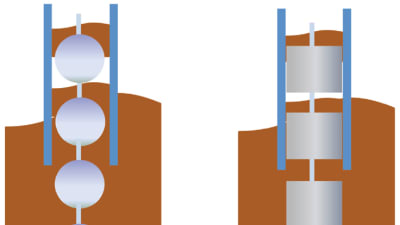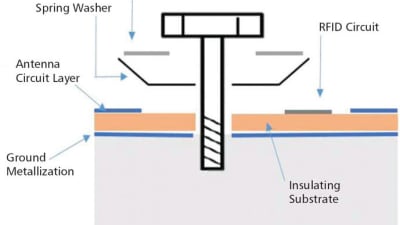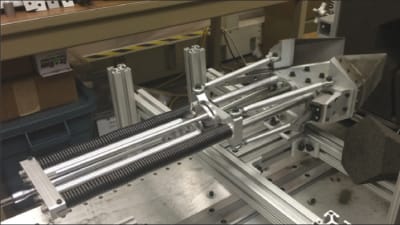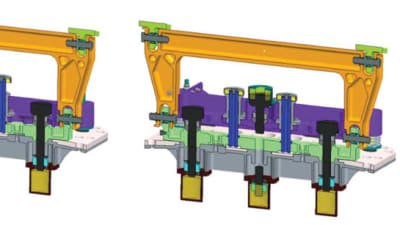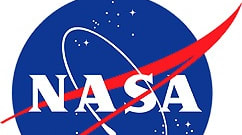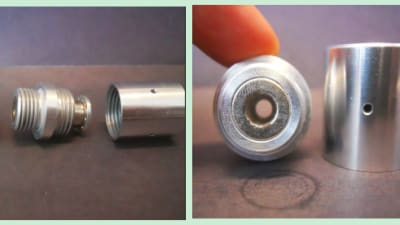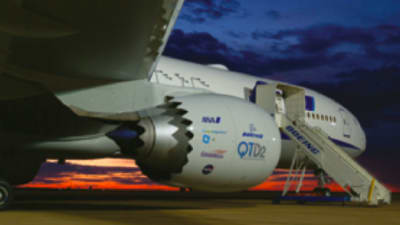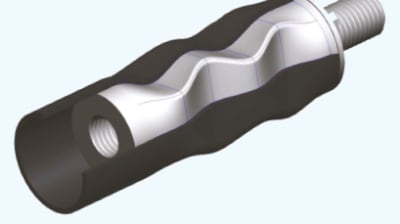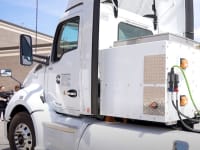39
61
169
-1
570
30
Briefs: Mechanical & Fluid Systems
Researchers at NASA's Armstrong Flight Research Center have developed a new technology to reduce inaccuracies in force/haptic feedback devices and systems. Used at NASA in aircraft...
Briefs: Mechanical & Fluid Systems
Low-Pressure Plasma Cleaning of Aerospace Components Using Breathing/Compressed Air
A method for precision cleaning of aerospace components is needed that does not use hazardous or environmentally harmful commodities. Historically, precision cleaning methods have utilized solvents that have contributed to the depletion of the ozone layer or had...
Briefs: Mechanical & Fluid Systems
The Mars 2020 coring drill will generate a significant amount of dust and debris (known as fines) due to the volume of milled material displaced by the corer's annulus. These cuttings must be removed to ensure that the...
Briefs: Mechanical & Fluid Systems
To measure organics in a fluid sample, one either has to bring the sample in the form of a colloid to the instrument, or extract the organics from the sample and bring the...
Briefs: Motion Control
Advanced Tool Drive System (ATDS) Camera Positioning Mechanism (CPM)
Robotic servicing of a satellite in low earth orbit (LEO) or geosynchronous Earth orbit (GEO) requires advanced systems capable of meeting the harsh environments of space. To support this effort, the Goddard Space Flight Center Satellite Servicing Capabilities Office (SSCO) has...
Briefs: Mechanical & Fluid Systems
Compact, Lightweight Trap Vent
This compact, lightweight trap vent is used to minimize the pressure differential of a high-altitude, balloon-borne detector. The vent allows the pressure to equalize rapidly, yet does not allow any light to enter the detector.
Briefs: Mechanical & Fluid Systems
Oxygen, water, and fuel are of paramount importance to human life. As a leading concept, the solid-oxide electrolysis cell (SOEC) is a very powerful technology, especially in...
Briefs: Mechanical & Fluid Systems
Low Solidity Vaned Diffuser (LSVD) Design for Improvement of Pressure Recovery
Many pump vaned diffuser designs are based on existing airfoil designs, with little attention given to the vane leading edge. There is a need for a vaned diffuser leading edge that helps resist flow separation and the resultant poor diffuser pressure recovery. Diffusers...
Briefs: Sensors/Data Acquisition
This technology is a low-cost RFID-based torque and tension sensor for high-performance fasteners, such as bolts, that are used in sophisticated high-tech equipment and systems. It offers the...
Briefs: Mechanical & Fluid Systems
Tangential Wrap Rib Deployable Reflector
There is a need for a large deployable reflector of 2-meter diameter or greater so smaller launch vehicles can be used. Common issues with going from a large solid reflector into deployable structures are the structural stiffness and deployable structure complexity.
Briefs: Motion Control
The BiBlade sampler has been developed for potentially acquiring samples from the surface of a planetary body. The tool could conceivably be used in both in situ and notional sample return missions to planetary bodies...
Briefs: Mechanical & Fluid Systems
The Orion Crew-Service Module (CM/SM) umbilical retention and release mechanism supports, protects, and disconnects all of the cross-module commodities...
Briefs: Mechanical & Fluid Systems
Great strides are taken to miniaturize spaceflight instrumentation, particularly analytical systems such as liquid chromatographs, gas chromatographs, and mass spectrometers....
Briefs: Mechanical & Fluid Systems
Fluid-pumped radiators are used to reject heat from structures to space. A fluid travels inside the structure to collect heat, and then travels...
Briefs: Mechanical & Fluid Systems
Filtering Molecules with Nanotube Technology
Innovators at NASA's Johnson Space Center have developed a filtration device to eliminate contaminants from water supplies. Originally developed to purify waste-water for reuse aboard the International Space Station, the innovation is applicable to numerous situations on Earth where there is a need to...
Briefs: Mechanical & Fluid Systems
Airfoil-Shaped Fluid Flow Tool for Use in Making Differential Measurements
Researchers at NASA’s Marshall Space Flight Center have developed a suite of adaptable flow measurement devices that can be easily installed without compromising the structural integrity of existing conduits. With their simple installation procedures, the devices can be...
Briefs: Mechanical & Fluid Systems
Piezo-Actuated, Fast-Acting Control Valve
High-power electric propulsion systems have the potential to revolutionize space propulsion due to their extremely high performance. This can result in significant propellant savings on space vehicles, allowing the overall mass to shrink for launch on a less expensive vehicle, or to allow the space vehicle...
Briefs: Mechanical & Fluid Systems
Interface Between STAR-CCM+ and 42 for Enhanced Fuel Slosh Analysis
Fuel slosh is excited during spacecraft maneuvers. The forces and torques exerted on the spacecraft by the slosh must be controlled by the attitude control system to maintain correct pointing and spacecraft orbit. In some rare cases, the attitude control system may excite the slosh...
Briefs: Motion Control
Mechanisms for Achieving Non-Sinusoidal Waveforms on Stirling Engines
The current state-of-the-art Stirling engines use sinusoidal piston and displacer motion to drive the thermodynamic cycle and produce power. Research performed at NASA Glenn has shown that non-sinusoidal waveforms have the potential to increase Stirling engine power density, and...
Briefs: Mechanical & Fluid Systems
RFID Cavity
This technology provides a method for interrogating collections of items with radio-frequency identification (RFID) tags. It increases the read accuracy, meaning that more of the item tags will be successfully read. It also permits smaller tag antennas than would otherwise be necessary.
Briefs: Mechanical & Fluid Systems
Method for Asteroid Volatile Extraction in Space
Some meteorites representative of certain classes of asteroids are 25% or more water by weight. This is consistent with infrared spectra of some asteroids, indicating hydrated minerals are abundant in some varieties of carbonaceous chondrite asteroids. Since water is very valuable in space, it would...
Briefs: Mechanical & Fluid Systems
Improving Stirling Engine Performance Through Optimized Piston and Displacer Motion
Stirling engines typically achieve high efficiency, but lack power density. Low power density prevents them from being used in many applications where internal combustion engines are viable competitors, and increases system costs in applications that require...
Briefs: Mechanical & Fluid Systems
A magnetically retained pressure-relief valve enables quick-open on/off operation when overpressure is reached.
Inventors at NASA’s Kennedy Space Center have developed a magnetically retained, fast-response pressure...
Briefs: Mechanical & Fluid Systems
Work Piece Cleaning Apparatus and Method with Pulsating Mixture of Liquid and Gas
NASA Goddard’s scientists have developed a novel, volatile organic compound (VOC)-free system for cleaning tubing and piping that significantly reduces cost and carbon consumption. The innovative technology enables the use of deionized water in place of costlier...
Briefs: Mechanical & Fluid Systems
Safety Drain System for Fluid Reservoir
Researchers at NASA’s Marshall Space Flight Center have developed a system that reduces the entrapment risks associated with a pool or spa’s recirculation drain. The technology prevents hazards caused by suction forces on the body, hair, clothing, or other articles. Employing a novel configuration of...
Briefs: Mechanical & Fluid Systems
Composites have excellent strength characteristics, are lightweight, and are increasingly being used in space applications. However, they are highly inflexible and require hinged joints when used...
Briefs: Mechanical & Fluid Systems
Temperature-Compensating PMT Housing
Shrinking or contracting light guides is a problem when photomultiplier tubes (PMTs) are glued to the guides. If there is no way to allow movement of the PMTs, when the temperature goes down, the light guide contracts and breaks the glue joint. The PMTs cannot be left loose to rattle around inside the detector....
Briefs: Aerospace
NASA’s Langley Research Center has created novel flow effector technology for separation control and enhanced mixing. The technology allows for variable shape control of aircraft structure through...
Briefs: Mechanical & Fluid Systems
NASA’s Langley Research Center has developed a composite joint connector that is more structurally efficient than joints currently on the market. Traditionally, composite joints can...
Top Stories
Blog: Manufacturing & Prototyping
2025 Holiday Gift Guide for Engineers: Tech, Tools, and Gadgets
Blog: Power
Using Street Lamps as EV Chargers
INSIDER: Semiconductors & ICs
Scientists Create Superconducting Semiconductor Material
Blog: Materials
This Paint Can Cool Buildings Without Energy Input
Blog: Software
Quiz: Power
Webcasts
 Upcoming Webinars: AR/AI
Upcoming Webinars: AR/AI
The Real Impact of AR and AI in the Industrial Equipment Industry
 Upcoming Webinars: Motion Control
Upcoming Webinars: Motion Control
Next-Generation Linear and Rotary Stages: When Ultra Precision...
 Podcasts: Manufacturing & Prototyping
Podcasts: Manufacturing & Prototyping
SAE Automotive Engineering Podcast: Additive Manufacturing
 Podcasts: Defense
Podcasts: Defense
A New Approach to Manufacturing Machine Connectivity for the Air Force
 On-Demand Webinars: Manufacturing & Prototyping
On-Demand Webinars: Manufacturing & Prototyping
Streamlining Manufacturing with Integrated Digital Planning and Simulation



